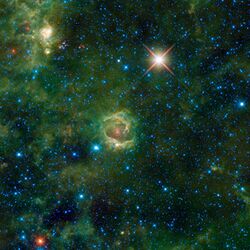Astronomy:IRAS 23304+6147
| Observation data Equinox J2000.0]] (ICRS) | |
|---|---|
| Constellation | Cassiopeia |
| Right ascension | 23h 32m 44.79s[1] |
| Declination | +62° 03′ 49.1″[1] |
| Apparent magnitude (V) | 12.99 - 13.15[2] |
| Characteristics | |
| Spectral type | G2Ia[3] |
| B−V color index | +2.31 - +2.37[2] |
| Variable type | Lb[2] |
| Astrometry | |
| Proper motion (μ) | RA: −3.731[1] mas/yr Dec.: −1.930[1] mas/yr |
| Parallax (π) | 0.2366 ± 0.0280[1] mas |
| Distance | approx. 14,000 ly (approx. 4,200 pc) |
| Details[3] | |
| Radius | 171[4] R☉ |
| Luminosity | 8,318 L☉ |
| Surface gravity (log g) | 0.0 cgs |
| Temperature | 5,900 K |
| Metallicity [Fe/H] | −0.61 dex |
| Other designations | |
2MASS J23324479+6203491 | |
| Database references | |
| SIMBAD | data |
IRAS 23304+6147 is a protoplanetary nebula in the constellation Cassiopeia, 16,000 light years away. The central star is a G-type supergiant.[5]
The nebula is carbon-rich and contains silicon, suggesting that it was formed by a star which was more massive than 4 M☉. Its spectrum also shows other s-process elements such as barium, yttrium, and lanthanum.[5]

The central star of the protoplanetary nebula has been found to be variable with a small range from visual magnitude +12.99 to +13.15. Although several periods have been identified, these change from year to year and the star has been classified as irregular.[2] The optical variability is dominated by slow pulsation with 83.8 d period, overlapped by faster pulsation modes.[7]
IRAS 23304+6147 is about 15,000 light years away and over eight thousand times as luminous as the sun. It lies in the direction of the Cassiopeia OB7 stellar association, but is thought to be further away.[5]
References
- ↑ 1.0 1.1 1.2 1.3 1.4 Vallenari, A. et al. (2022). "Gaia Data Release 3. Summary of the content and survey properties". Astronomy & Astrophysics. doi:10.1051/0004-6361/202243940 Gaia DR3 record for this source at VizieR.
- ↑ 2.0 2.1 2.2 2.3 Hrivnak, Bruce J.; Lu, Wenxian; Maupin, Richard E.; Spitzbart, Bradley D. (2010). "Variability in Proto-planetary Nebulae. I. Light Curve Studies of 12 Carbon-rich Objects". The Astrophysical Journal 709 (2): 1042–1066. doi:10.1088/0004-637X/709/2/1042. Bibcode: 2010ApJ...709.1042H.
- ↑ 3.0 3.1 Klochkova, V. G.; Szczerba, R.; Panchuk, V. E. (2000). "Optical Spectrum of the Infrared Source IRAS 23304+6147". Astronomy Letters 26 (2): 88. doi:10.1134/1.20372. Bibcode: 2000AstL...26...88K.
- ↑ Stassun, Keivan G. et al. (9 September 2019). "The Revised TESS Input Catalog and Candidate Target List". The Astronomical Journal 158 (4): 138. doi:10.3847/1538-3881/ab3467. Bibcode: 2019AJ....158..138S.
- ↑ 5.0 5.1 5.2 Klochkova, V. G.; Panchuk, V. E.; Tavolzhanskaya, N. S. (2015). "Peculiarities of the atmosphere and envelope of a post-AGB star, the optical counterpart of IRAS 23304+6347". Astronomy Letters 41 (1–2): 14–22. doi:10.1134/S1063773715020024. Bibcode: 2015AstL...41...14K.
- ↑ "ASAS-SN Variable Stars Database". ASAS-SN. https://asas-sn.osu.edu/variables/lookup.
- ↑ Hrivnak, Bruce J.; Henson, Gary; Hillwig, Todd C.; Lu, Wenxian; Murphy, Brian W.; Kaitchuck, Ronald H. (January 2020). "Variability in Proto-planetary Nebulae. VI. Multitelescope Light Curve Studies of Several Medium-bright (V = 13–15), Carbon-rich Objects". The Astronomical Journal 159 (1): 21. doi:10.3847/1538-3881/ab564c. Bibcode: 2020AJ....159...21H.
 |


